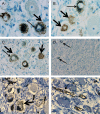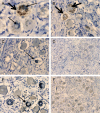Apparent expression of varicella-zoster virus proteins in latency resulting from reactivity of murine and rabbit antibodies with human blood group a determinants in sensory neurons
- PMID: 22013055
- PMCID: PMC3255922
- DOI: 10.1128/JVI.05950-11
Apparent expression of varicella-zoster virus proteins in latency resulting from reactivity of murine and rabbit antibodies with human blood group a determinants in sensory neurons
Abstract
Analyses of varicella-zoster virus (VZV) protein expression during latency have been discordant, with rare to many positive neurons detected. We show that ascites-derived murine and rabbit antibodies specific for VZV proteins in vitro contain endogenous antibodies that react with human blood type A antigens in neurons. Apparent VZV neuronal staining and blood type A were strongly associated (by a χ² test, α = 0.0003). Adsorption of ascites-derived monoclonal antibodies or antiserum with type A erythrocytes or the use of in vitro-derived VZV monoclonal antibodies eliminated apparent VZV staining. Animal-derived antibodies must be screened for anti-blood type A reactivity to avoid misidentification of viral proteins in the neurons of the 30 to 40% of individuals who are blood type A.
Figures



References
-
- Arend P. 2011. “Natural” antibodies and histo-blood groups in biological development with respect to histo-blood group A. Immunobiology 216:1318–1321 - PubMed
-
- Arend P, Nijssen J. 1977. A-specific autoantigenic ovarian glycolipids inducing production of ‘natural’ anti-A antibody. Nature 269:255–257 - PubMed
-
- Baumgarth N, Tung JW, Herzenberg LA. 2005. Inherent specificities in natural antibodies: a key to immune defense against pathogen invasion. Springer Semin. Immunopathol. 26:347–362 - PubMed
-
- Dodd J, Solter D, Jessell TM. 1984. Monoclonal antibodies against carbohydrate differentiation antigens identify subsets of primary sensory neurones. Nature 311:469–472 - PubMed
-
- Finstad CL, et al. 1991. Some monoclonal antibody reagents (C219 and JSB-1) to P-glycoprotein contain antibodies to blood group A carbohydrate determinants: a problem of quality control for immunohistochemical analysis. J. Histochem. Cytochem. 39:1603–1610 - PubMed
Publication types
MeSH terms
Substances
Grants and funding
LinkOut - more resources
Full Text Sources
Medical

